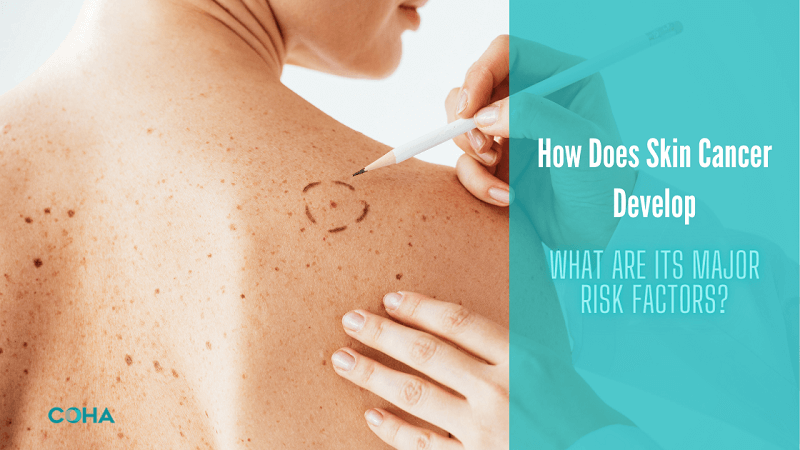Skin cancer is the most common form of cancer in the US, including three types: squamous cell carcinoma, basal cell carcinoma, and melanoma. Non-melanoma skin cancers (basal cell and squamous cell cancers) contribute to 95% of all skin cancers and are curable if diagnosed and treated early. Melanoma skin cancer is the most serious type, contributing to 75% of all skin cancer deaths. If left untreated, it can spread to other organs, making it difficult to control.
Read more to learn the causes, risk factors, and symptoms of skin cancer.
Does UV Radiation Cause Skin Cancer?
Ultraviolet (UV) radiation emitted from the sun is one of the primary causes of skin cancer. Lifetime or overexposure to the sun causes non-melanoma skin cancers on sun-exposed parts of the body. Melanoma skin cancers are also related to sun exposure, but not as strongly as non-melanoma cancers. Some artificial sources of UV rays are also associated with skin cancer.
UV radiation induces cellular alterations which are in sync with the characteristics of cancer. These include genomic instability and mutation and initiating tumor-promoting inflammations. These abnormal cellular behaviors indicate cancer and enhance the development and evolution of the tumors.
How Are People Exposed to UV Radiation?
Sunlight
Sunlight is the major source of UV radiation. UV rays reach the ground in different types and at different levels. 95% of ground-hitting UV rays are UVA rays, and 5% being UVB rays.
The UV rays’ strength varies depending on these factors:
- Season-UV rays are stronger in the summer and spring seasons.
- Altitude-The ground at higher elevations receives more UV rays.
- Time of Day - UV rays are stronger between 10 am and 4 pm.
- Clouds-Despite the varying effects of clouds, UV rays can reach the ground even on a cloudy day.
- Air Contents-Ozone in the upper atmosphere filters out some UV rays.
- Distance from the Equator (Latitude)-UV exposure decreases when you move far from the equator.
- Reflection off Surfaces-Surfaces like pavement, grass, sand, snow, and water reflect UV rays, leading to increased exposure.
A person’s UV exposure amount varies depending on its strength, the length of exposure, and whether the skin is protected with sunscreen or clothing.
Man-Made Sources of UV Rays
- Phototherapy-This treatment uses UV, UVA, and UVB rays to treat certain skin issues.
- Tanning Beds and Booths- These sources emit UVA rays (predominantly) and UVB rays.
- Mercury-Vapor Lamps -These lamps contain two bulbs, an inner bulb that emits light and UV rays and an outer bulb that filters out UV rays. Unless the outer bulb breaks, they do not cause UV exposure.
- Black-Light Lamps -These lamps emit UV rays (mostly UVA).
- High-Pressure Xenon and Xenon-Mercury Arc Lamps -These lamps are used as sources of UV rays for UV curing, disinfection, stimulating sunlight, and car headlights.
- Plasma Torches and Welding Arcs-These are the major concerns of workplace UV exposure.
Skin Cancer Causes and Risk Factors
- People with light eyes, blond or red hair, and fair or freckled skin that burns easily
- A history of severe sunburns
- People with an outdoor job or living in a sunny climate
- Several or abnormal moles
- Precancerous skin lesions
- Family history of skin cancer
- Radiation treatment/therapy
- Exposure to arsenic
- Human papillomavirus
- A weakened immune system
Symptoms of Skin Cancer
A change on the skin, including either a new mole, variation in an existing mole, or skin lesion, is the most common warning sign of skin cancer.
- Basal cell carcinoma appears as a smooth, small, waxy, or pearly bump on the neck, face, or ears or a flat pink, red, or brown lesion on the arms and legs or trunk.
- Squamous cell carcinoma occurs as a solid, red nodule or irregular, scaly flat lesion that may bleed and become crusty.
- Melanoma appears as a brownish patch or bumps, with darker speckles resembling a normal mole, usually in an abnormal shape. Melanoma can also occur as dark lesions on several areas in your body like your palms, soles, fingertips, toes, etc.
Signs of Melanoma
A mole or skin lesion with:
- Asymmetrical shape
- Blurred or ragged edges
- Uneven color shades portions that appear red, white, pink, blue, or bluish-black
- A significant change in size
- Itching and burns or bleeds
How Is Skin Cancer Diagnosed?
Your provider will perform a biopsy to diagnose skin cancer and its stage and type. It involves examining your tissue sample under a microscope for any changes or abnormalities on the skin.
Contact Chesapeake Oncology Hematology Associates today for skin cancer diagnosis or if you have any questions about cancer.


